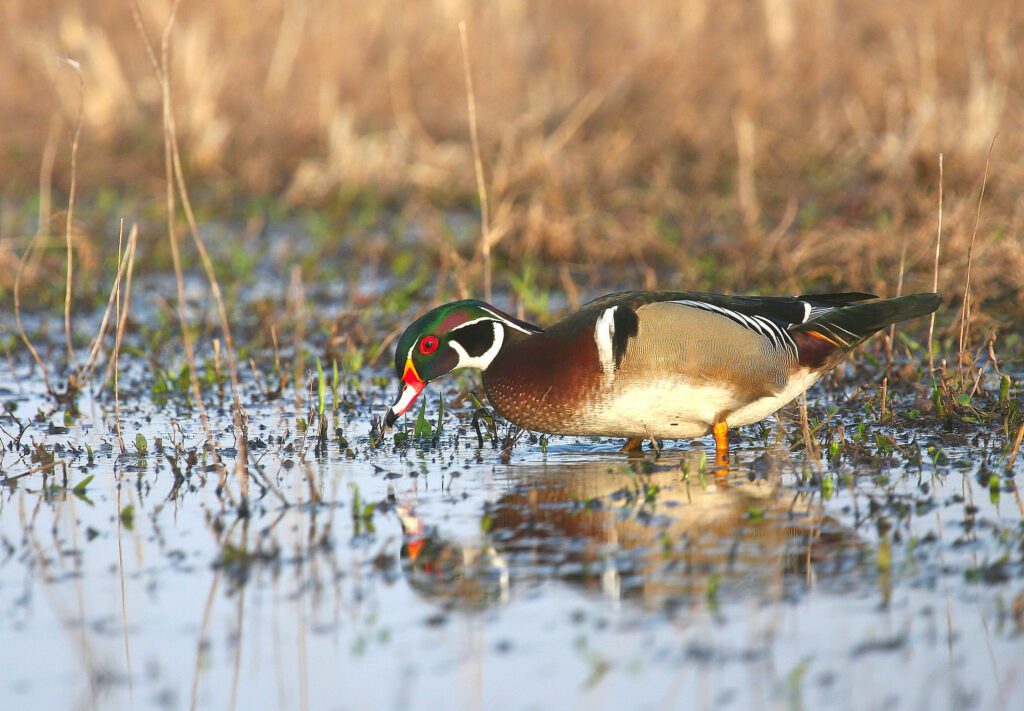Wood ducks are thriving today in wetland areas across the United States. But this wasn’t always the case, according to a new Wildlife Watch from the U.S. Fish and Wildlife Service (FWS).
Once on the brink of extinction, wood ducks nearly disappeared from America’s skies—mirroring the fate of other species that vanished during the 20th century. A 2019 study published in Science revealed that the country has lost nearly three billion birds since 1970. Yet the wood duck’s remarkable recovery offers hope.
“The successful comeback of the wood duck can serve as a model for the recovery of other North American bird species,” the American Bird Conservancy said in its profile on the species.
Known for their emerald crests and shimmering multicolored plumage, the males, especially during the spring breeding season, are particularly dazzling with feathers that range from deep greens and blues to bright white and cream.
Found mostly near rivers, swamps and ponds that provide plenty of shade, the species is unique. They nest in tree cavities and, unlike most ducks, have clawed feet that help them perch on branches, an ability that sets them apart.
A wood duck in marshy waters. Wood ducks eat a variety of things, but the majority of their diet consists of plant material.
A wood duck in marshy waters. Wood ducks eat a variety of things, but the majority of their diet consists of plant material.
Clayton Ferrell/USFWS
But at the beginning of the 20th century, a conservation crisis was unfolding. “The early 1900s saw a devastating decrease in population for commonly hunted birds, including the wood duck,” Kylie Huang of the FWS wrote in the Wildlife Watch. “For many years, hunting regulations were few and far between, allowing market hunters to hunt birds faster than they could reproduce.”
Logging and the draining of wetlands also impacted populations, as this species needs mature trees that have cavities to breed.
This, Huang said, was “the perfect recipe for extinction.”
Historical evidence at the time painted a dire picture. “[Wood ducks] are becoming very scarce and are likely to be exterminated before long,” ornithologist George Bird Grinnell wrote in 1901.
So, what changed?
In 1918, Congress passed the Migratory Bird Treaty Act which led to a moratorium on Wood Duck hunting across the U.S. Prohibition of hunting lasted until 1940, after the “Duck Stamp Act” of 1934 was introduced, “requiring hunters to purchase a duck stamp to legally hunt waterfowl,” Huang wrote.
Additional legislation, such as the Pittman-Robertson Act (formally the Federal Aid in Wildlife Restoration Act of 1937) and the North American Wetlands Conservation Act of 1989, provided crucial support for wetland and waterfowl conservation projects nationwide, playing a key role in the recovery of wood duck populations.
Nest boxes were another important factor. According to Huang, “they provide a similar structure to the holes in trees a wood duck would naturally nest in.”
She added, “If you have ever seen a simple birdhouse on a pole in the middle of a pond or wetland, it could likely be a wood duck nest box and might even have baby ducklings inside.”
Today, wood duck populations are in excess of 3.5 million and are increasing. However, they still face threats from habitat loss, with conservation efforts today just as important as those of the past.
On Sept. 10, the Department of the Interior announced a $46.2 million grant scheme designed to conserve and restore more than 90,000 acres of wetland serving as habitats for waterfowl and shorebirds in 17 states.
This is in addition to $11.7 million from the Migratory Bird Conservation Fund, which will provide the FWS and its partners with the ability to conserve bird habitats in wildlife refuges across seven states.
“Investing in wetland conservation is an investment in the health of our environment and our economy. These grants will preserve essential habitats for migratory birds and boost local economies through enhanced recreational opportunities,” Secretary Deb Haaland said in a statement.
Service Director Martha Williams added, “Across the country, migratory birds and their habitat are at risk due to drought, warmer temperatures and rising seas. Projects supported through these grants help bolster wetland biodiversity and increase habitat for billions of migrating birds while expanding outdoor recreation opportunities for surrounding communities.”
Do you have a tip on a science story that Newsweek should be covering? Do you have a question about conservation efforts or wood ducks? Let us know via science@newsweek.com.
References
Rosenberg, K. V., Dokter, A. M., Blancher, P. J., Sauer, J. R., Smith, A. C., Smith, P. A., Stanton, J. C., Panjabi, A., Helft, L., Parr, M., & Marra, P. P. (2019). Decline of the North American avifauna. Science, 366(6461), 120—124. https://doi.org/10.1126/science.aaw1313
Source link : http://www.bing.com/news/apiclick.aspx?ref=FexRss&aid=&tid=66fed788cd974d78b544535d99f6910d&url=https%3A%2F%2Fwww.newsweek.com%2Fwood-duck-recovery-offers-hope-endangered-birds-across-america-1963376&c=14197193149123140068&mkt=en-us
Author :
Publish date : 2024-10-03 05:41:00
Copyright for syndicated content belongs to the linked Source.
